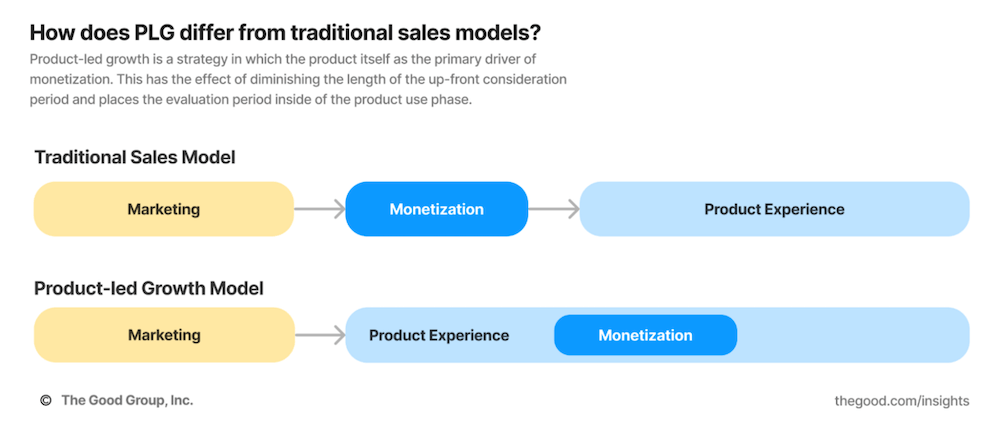
How Does Experimentation Support Product-Led Growth?
Smart experimentation transforms product-led growth from guesswork into an engine for sustainable scale.
The product-led growth (PLG) playbook is no longer a secret. Free trials, frictionless onboarding, viral mechanics. Many SaaS companies are following the same script. Yet despite implementing all the product-led growth best practices, most companies leveraging these strategies hit a growth plateau, watching competitors with seemingly similar products pull ahead.
Here’s what they’re missing: the most successful product-led companies don’t just follow the playbook. They rewrite it based on what their actual users reveal through experimentation.
While everyone else copies best practices, companies that layer experimentation into their PLG strategy are discovering the specific insights that accelerate their growth. In a world where everyone has access to the same tactics, the ability to learn about your own users (and do it faster) becomes a moat.
Companies like Booking.com, Netflix, and Amazon didn’t achieve their dominance by following conventional wisdom. They made experimentation central to their success, running thousands of experiments annually to optimize their user experience. And you don’t need their resources to adopt their approach.
What is product-led growth?
Product-led growth is a strategy that emphasizes the product itself as the primary driver of customer acquisition, conversion, and retention.
Traditionally, companies have relied on sales and marketing tactics to create leads and drive customer adoption. Ads and websites had to do most of the selling, and the onus was on the potential user to read ads, navigate websites, choose between feature matrices, and, at times, go through a complicated sales process (on or off-site).
In a product-led growth model, companies remove as many obstacles as possible to acquiring free registered users. This approach often involves offering a free or freemium version of the product, allowing users to experience its value before committing to a paid subscription.

If the experience is good enough to keep them using it, and the paid features are valuable enough, then the hope is that users will ultimately convert into paying customers. In this way, the product serves as the main vehicle for customer acquisition and expansion.
Just like test driving a car, they let you test drive their product and discover the value on your own, before making a purchase decision.
Companies that successfully implement a product-led growth strategy often benefit from increased customer loyalty, higher conversion rates, lower customer acquisition costs, and sustainable long-term growth.
The shift from “launch and learn” to “test and learn”
Plenty of companies, between product-market fit and scale, run their growth strategies on a “launch and learn” philosophy. They build features based on hunches, ship them to users, then analyze the results afterward. This approach can work, but when operating on a product-led growth model, product decisions carry outsized impact. The product experience influences pretty much every KPI from acquisition to retention.
When you launch first and learn later, you’re essentially gambling with your users’ experience. Every poorly conceived feature, every friction point, every missed opportunity represents lost revenue and potentially churned customers. More importantly, it represents wasted development resources that could have been deployed more strategically.
This is where experimentation comes in. Instead of “launch and learn,” companies can shift to “test and learn.” This means experimentation and analysis of results happen pre-launch, not after. Changes are validated with real users before full implementation, minimizing risk and maximizing ROI.
Experimentation before implementation gives you an understanding of real customer behavior and clearly indicates how you can repeat results by uncovering the why behind those behaviors.
Enjoying this article?
Subscribe to our newsletter, Good Question, to get insights like this sent straight to your inbox.
How experimentation amplifies PLG success
Experimentation is only helpful to a product-led growth strategy when it is done right. So what are some of the ways to implement that will amplify PLG success?
1. Systematic optimization across the customer journey
The most effective approach to PLG experimentation uses frameworks like ROPES (Registration, Onboarding, Product, Evangelize, Save) to systematically optimize each stage of the customer experience. Rather than randomly testing features, successful companies identify specific levers within each stage and experiment systematically.
For example:
- Registration phase: Testing form length, social proof elements, and value propositions
- Onboarding phase: Experimenting with tutorial formats, progress indicators, and time-to-value optimization
- Product phase: Testing feature discoverability, UI changes, and user flow improvements
- Evangelize phase: Optimizing sharing mechanisms, referral programs, and viral loops
- Save phase: Testing retention tactics, upgrade prompts, and churn prevention strategies
This systematic approach ensures that experimentation efforts are strategic rather than scattered, creating compounding improvements across the entire user journey.
2. Accelerated learning through parallel testing
Traditional A/B testing approaches test one hypothesis at a time, which can drastically slow your learning velocity. Advanced PLG companies run multiple experiments simultaneously across different parts of their product experience, dramatically increasing the rate at which they gather insights.
The key to successful parallel testing is ensuring experiments don’t interfere with each other. As Natalie Thomas, our Director of UX and Strategy, explains: “It’s important to look at behavior goals to assess why your metrics improved after a series of tests. So if you’re running too many similar tests at once, it will be difficult to pinpoint and assess exactly which test led to the positive result.”
Successful parallel testing requires:
- Creating testing roadmaps that cover independent product areas
- Building small, cross-functional teams assigned to each area
- Establishing clear metrics and success criteria for each test
- Implementing proper statistical controls to avoid interference
3. Rapid experimentation for faster innovation
Speed matters in PLG. Market opportunities disappear quickly, and user expectations evolve constantly.
So, one of the main objections to implementing an experimentation strategy is that testing cycles often take weeks or months to complete. But high-performing PLG companies have found ways to cut this time in half without losing statistical rigor. Key strategies include:
Supplementing A/B Tests with Rapid Testing: Not every hypothesis requires a full A/B test. Qualitative research, user interviews, and rapid prototyping can validate concepts quickly before investing in development.
Modular Testing Approaches: Instead of starting from scratch each time, successful teams create reusable components like design templates, testing frameworks, and analysis processes to reduce setup time.
AI-Powered Research: Using artificial intelligence as a research assistant to speed up data collection, user recruitment, and insight generation.
Prioritization Frameworks: Implementing systematic prioritization (like the ADVIS’R framework) to ensure high-impact experiments get fast-tracked through the process.
4. Data-driven feature development
Experimentation helps PLG companies avoid the biggest roadmap mistake: prioritizing low-impact features. Instead of building what seems logical, experimentation reveals what actually drives user behavior and business metrics.
This is particularly important as you scale beyond basic PLG practices. When you’re competing with other product-led companies, the quality of your feature decisions becomes a key differentiator. Companies that systematically test and validate features before full development consistently outperform those that rely on intuition.
The most successful approach combines quantitative testing with qualitative insights. This means not just measuring what users do, but understanding why they do it. This deeper understanding enables teams to build features that truly resonate with users rather than features that just check boxes.
5. Building an experimentation-first culture
An outcome of adding experimentation to a product-led growth strategy is that it will help build the practice into your company culture. To do that, you can follow a few key steps.
Start with infrastructure
Before you can effectively use experimentation to support PLG, you need the right infrastructure. This includes:
- Testing platforms that can handle both simple A/B tests and complex multivariate experiments
- Analytics systems that provide real-time insights into user behavior
- Data pipelines that connect user actions to business outcomes
- Collaboration tools that enable cross-functional teams to work together effectively
Establish clear processes
Successful experimentation requires discipline. Teams need clear processes for:
- Hypothesis formation and validation
- Test design and statistical planning
- Resource allocation and project management
- Results analysis and decision-making
- Knowledge sharing and organizational learning
Foster cross-functional collaboration
The most impactful experiments often come from unexpected sources. Engineers closest to the code understand technical constraints and opportunities. Designers see user experience friction points. Customer success teams hear directly from users about pain points.
Creating space for these diverse perspectives to contribute to experimentation efforts often leads to breakthrough insights that no single team would discover independently.
The compound effect of systematic experimentation
What makes experimentation so powerful for PLG companies is its compound effect. Each successful experiment doesn’t just improve one metric. It teaches you something about your users that informs future experiments.
Over time, this creates an accelerating cycle of improvement. Companies that have been systematically experimenting for years possess a deep, nuanced understanding of their users that newcomers can’t easily replicate. This understanding becomes a sustainable competitive advantage.
Moreover, experimentation capabilities themselves improve with practice. Teams get faster at designing tests, more sophisticated in their analysis, and better at translating insights into action. The infrastructure and culture that support experimentation become organizational assets that compound over time.
Experimentation as your PLG multiplier
Product-led growth without experimentation is like driving with your eyes closed. You might reach your destination, but probably not efficiently, and certainly not safely. Experimentation transforms PLG from a collection of best practices into a systematic approach to user-centered product development.
The companies that win in today’s competitive SaaS landscape aren’t just those with the best products; they’re those that can consistently improve their products based on real user insights. They’ve made experimentation not just a tactic, but a core organizational capability.
Ready to transform your PLG strategy with systematic experimentation? The Good specializes in helping product-led companies build experimentation capabilities that drive sustainable growth.
Our Digital Experience Optimization Program™ combines strategic frameworks like ROPES with hands-on experimentation support to help you uncover the specific insights your business needs to scale. Let’s explore how experimentation can accelerate your growth →
Enjoying this article?
Subscribe to our newsletter, Good Question, to get insights like this sent straight to your inbox.

About the Author
Katie Encabo
Katie Encabo is the Customer Success Manager at The Good. She focuses on supporting and improving the experience of top-performing ecommerce and SaaS growth teams as they optimize the digital experience for their users.